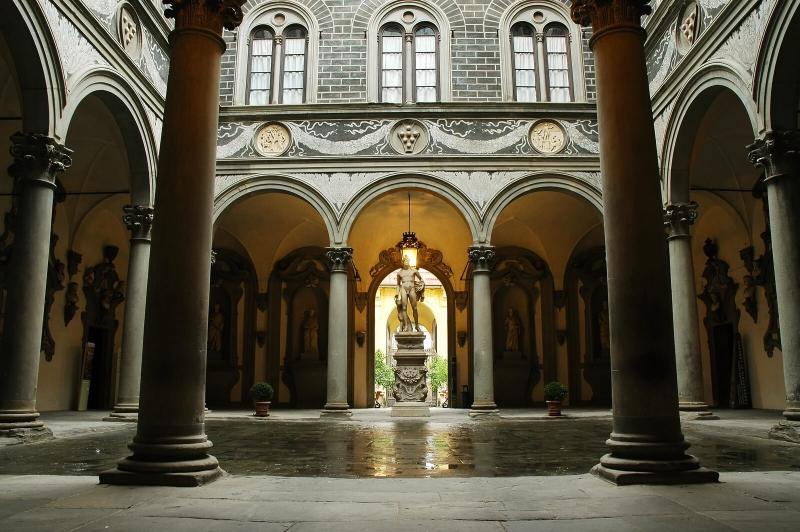The Artistic Jewel in Palazzo Medici Riccardi Few Bother to Visit
ITA:

Use player to listen to Italian version
When it was built in the 15th century, Palazzo Medici surpassed all other Florentine palaces in size and grandeur. Commissioned in 1444 by Cosimo il Vecchio, the patriarch of the Medici family, to his friend Michelozzo, an architect and a sculptor, it is inspired by classical Roman and Brunelleschian principles, making the building exquisitely Florentine.
While Cosimo only moved there in the last years of his life because he found it too big, his grandson Lorenzo il Magnifico established a princely court where poets, philosophers and artists, including Pico della Mirandola, Poliziano and Botticelli, often gathered.
In 1540, Cosimo I moved to Palazzo Vecchio, and after more than a century, it was sold to the Riccardi family, hence the name it bears today.
Not many visitors may be aware of the artistic jewel that is housed on the first floor of the palace, the Magi Chapel, whose walls are decorated with frescoes by Benozzo Gozzoli, painted in 1459. Using the theme of the Ride of the Magi, Gozzoli made a brilliant and picturesque portrayal of Florentine life. The work of art was intended as a homage to the Medici court and depicted the 1439 council that contributed to the dynasty’s, and the city’s, prestige.
Amid a landscape populated with knights, animals, hunting scenes, slight trees, strange rocks, a hilltop castle with towers, stands the procession with many illustrious Florentines, members of the Medici family, including Cosimo il Vecchio and Lorenzo il Magnifico, and their friends, as well as visitors from the East, who can be recognized thanks to their lavish clothes and the beards – in Florence, hairless faces were the trend at the time.
The chapel is accessed by entering the elegant courtyard, which features the Medici emblem on the cornice between the arcades of the portico and the first floor.
Quando fu costruito nel XV secolo, Palazzo Medici superò tutti gli altri palazzi fiorentini per dimensioni e grandezza. Commissionato nel 1444 da Cosimo il Vecchio, patriarca della famiglia Medici, al suo amico Michelozzo, architetto e scultore, si ispira nelle forme a principi della romanità classica e brunelleschiani, rendendo l'edificio squisitamente fiorentino.
Mentre Cosimo vi si trasferì solo negli ultimi anni di vita perché lo ritenne troppo grande, suo nipote Lorenzo il Magnifico vi istituì una corte principesca dove si riunivano poeti, filosofi e artisti, tra cui Pico della Mirandola, Poliziano e Botticelli.
Nel 1540, Cosimo I si trasferì a Palazzo Vecchio e, dopo oltre un secolo, il palazzo fu venduto alla famiglia Riccardi, da qui il nome che porta oggi.
Non molti visitatori forse sono a conoscenza del gioiello artistico che si cela al primo piano del palazzo, la Cappella dei Magi, le cui pareti sono decorate con affreschi di Benozzo Gozzoli, dipinti nel 1459. Utilizzando il tema della Cavalcata dei Magi, Gozzoli realizzò un brillante e pittoresco ritratto della vita fiorentina. L'opera fu intesa come omaggio alla corte dei Medici e commemora il concilio del 1439 che contribuì al prestigio della dinastia e della città.
In mezzo a un paesaggio popolato di cavalieri, animali, scene di caccia, esili alberi, strane rocce, un castello con torri in cima a una collina, si svolge il corteo con molti illustri fiorentini, membri della famiglia Medici, tra cui Cosimo il Vecchio e Lorenzo il Magnifico, e i loro amici, ed anche visitatori provenienti dall'Oriente, riconoscibili grazie ai loro vestiti sontuosi e alle barbe: a Firenze, andavano di moda i volti glabri.
Si accede alla cappella passando per l'elegante cortile, che presenta lo stemma dei Medici sulla cornice tra le arcate del portico e il primo piano.











